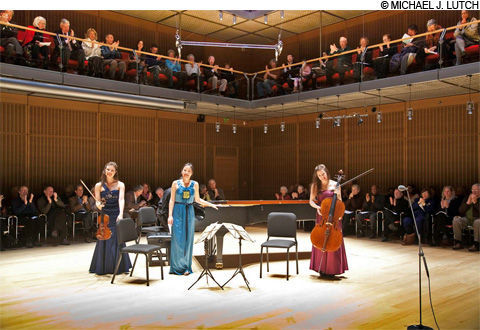
TESTING THE ACOUSTICS The Claremont Trio inaugurated the Gardner Museum’s new Calderwood Hall. |
What a turbulent time we've been having in Boston's musical life. People are talking less about music itself than about companies closing, celebrated performers canceling, and the firing of a beloved musician. On the other hand, there's another hand. We've now had the opening of an elegant (though acoustically challenging) new concert hall in the new wing of the Gardner Museum; the premiere of a wondrous new symphony by John Harbison, commissioned by James Levine and the Boston Symphony Orchestra; the Boston debut of an exciting young conductor; and radiant versions of seldom-heard late-20th-century Schnittke and Pärt choral masterpieces by David Hoose and the Cantata Singers (best known for their deeply austere Bach). Significant pleasures along with the pain.
>> PHOTOS: Boston Symphony Orchestra & Claremont Trio <<
I've now heard two concerts at the Gardner's new Calderwood Hall, a just-under 300 seat auditorium with a square central performing area and three-levels of narrow single-row balconies surrounding the players. At a donor's preview, Paavali Jumppanen played Beethoven's Moonlight and Lebewohl sonatas on a lidless piano (better tone? better sight lines?) that sounded both warm and bright, though his playing was antiseptic and inexpressive. Then in Beethoven's Kreutzer Sonata, he was joined by the livelier Corey Cerovsek, whose fine violin sounded oddly unreverberant.
This lack of resonance was a bigger problem at the official public opening the following Sunday. The Claremont Trio played Mozart's late C-major Trio, K. 548, a newly commissioned Trio by the young composer Sean Shepherd, and the luscious Mendelssohn D-minor Piano Trio. Sitting in the first balcony, behind the players, I could hardly hear the strings over the lidless piano, and what I could hear sounded thin and dry. I moved up to the second balcony (quite dizzying up there, but similar sound) for the Shepherd, which had many appealing moments, especially in the pretty second movement, which begins with solo cello and ends with solo violin. Back in the first balcony for the Mendelssohn, I was more disappointed by the lack of rhapsodic thrust than the thin string sound. The concert was broadcast live on WGBH and featured announcer Cathy Fuller interviewing Shepherd. Unamplified, their voices didn't carry up to the second balcony. I'm sure it will take at least a season of fiddling with the acoustics (by the celebrated Disney Hall acoustician Yasuhisa Toyota), just as Ozawa Hall at Tanglewood took a year to work out its acoustical lumps. (By the way, given only a low glass barrier at the edge of the balconies and the unobstructed view they offer of patrons' laps, I'd advise women not to wear short dresses.)
John Harbison's Symphony No. 6 is a new treasure, and it seemed to be getting a superlative performance from the BSO and refined and eloquent Irish mezzo-soprano Paula Murrihy, under the baton of David Zinman, who replaced James Levine, the originally intended conductor. Like Harbison's Fifth Symphony, it has a vocal element. The first movement sets a haunting James Wright poem, "Entering the Temple in Nimes," a subtle evocation of the difficulty of re-entering the past and the world of art. The end of the movement, with the entrance of the cimbalom (a Hungarian hammered dulcimer), is ravishing, one of the most magical moments Harbison has ever written. The meditative and moving second movement, the rambunctious and almost violently syncopated Scherzo, and the dissolving finale all pick up on themes first laid out in the vocal movement. I'm not yet hearing how all the pieces fit, yet I love what I hear and can't wait for another try.